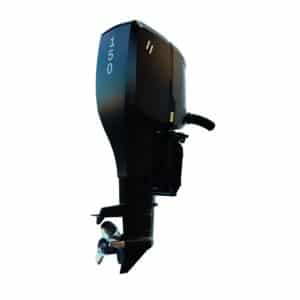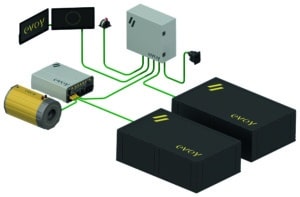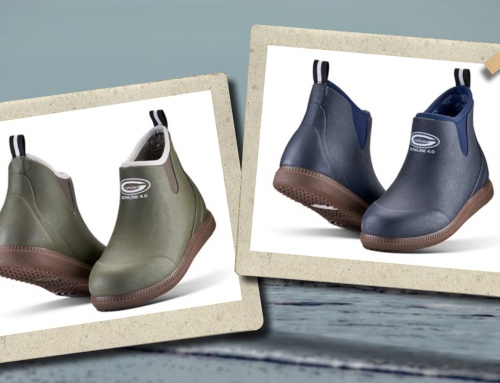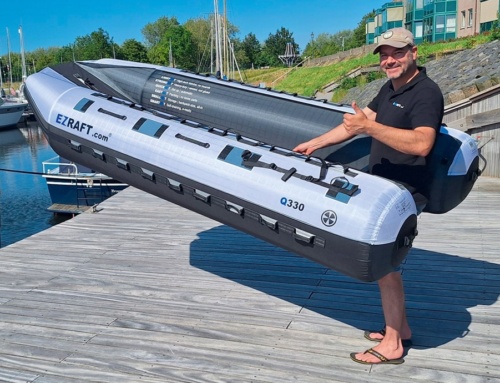The electric outboard has just taken a leap forward with the Evoy 150.

This 150hp engine weighs 200kg, but its bigger 300hp and 450hp siblings will not weigh much more.
The big electric outboard is generally seen as a pipe dream, and not without good reason. As we know, boats, even small ones, consume large quantities of fuel and have identical appetites for kilowatts. However, it appears that the concept of electric planing power may become more realistic with the production of a range of big electric outboards. With models spanning from 150hp to 450hp, Norwegian company Evoy are building on their experience from having already developed an array of inboard electrical power plants. In support of this, and no less important, is an expanding network of dockside recharging points that can keep this amount of marine e-power on the go.
Evoy have been developing their electric outboard for the last three years. Their maiden 150hp model has now finished development, with the first commercial customers due to take delivery this autumn – shortly followed by a roll-out for pleasure boaters. They also have 300hp and 450hp versions in the pipeline, so one can suppose that these are modular developments of the 150hp engine. The basic package includes a 63kWh lithium battery, which weighing 400kg is double the weight of the engine itself. This can be expanded on up to 189kWh, with each 63kWh module providing around an 18nm range at about 25 knots, it is claimed. Theoretically, this means that you could have a cruising range of around 54nm in a planing boat if you opted for the triple-battery set-up. In a displacement boat, where power needs are much smaller and range subsequently greater, having 1.2 tonnes of lithium batteries under the deck makes better sense. Evoy have already fitted their first production 400hp inboard electric propulsion system to a Norwegian fisheries craft – a boat large enough to easily handle the extra displacement.
This inboard motor can either drive through shafts or outdrives and, like the forthcoming outboard range, comes in three outputs: 150hp, 230hp and 400hp. These engines have some interesting specifications, particularly in terms of weight and torque – crucial aspects for marine engines. The 150hp, 230hp and 400hp engines, having no external outboard body or heavy engine block, weigh just 55kg, 100kg and 150kg, respectively. The torque figures are even more impressive as the 150hp engine can produce a peak torque figure of 258ft/lb (350Nm) for short periods. The 400hp engine, spinning at a leisurely 3750rpm, can maintain a continuous 570ft/lb and peak at 1100ft/lb when needed. All three engines have a peak power facility that massively exceeds their continuous rating, which with the 400hp engine is doubled to 800hp. How long this output can be maintained has not been clarified, but considering battery drain it can’t be long. It would not be unrealistic to suppose that with the same electric motors powering the outboard engines, torque figures will be very similar. As electric motors develop the same torque at 1rpm as they do at maximum RPM, I suspect that like the German Torqeedo electric outboard, these engines will have a torque limiter at low engine speed. This is needed to prevent bevel gear/transmission damage from the very high levels of initial power delivery, which a fossil fuel engine is not capable of at such low engine speed.

The complete inboard set-up, like the outboard system, has a smart charging facility and touch screen control and monitoring.
Electrical propulsion, especially with such high-power outputs, is only made realistic by a power supply from a substantial lithium battery, and a recharging system that can get a high-capacity battery back to full power in a relatively short period of time. Evoy’s current inboard 400hp engine comes with their ‘Super AC Charging’ system, which working with any AC outlet can recharge any size battery bank. This is a 3.3kW charger requiring a 16A 230V supply, and depending on the mains power outlet and battery bank capacity it can take up to 24 hours to recharge a 63kWh battery. Alternatively, you can opt to install the land-based DC Super Charging Station for a faster power resupply. The technology that has gone into developing batteries like the one fitted to BMW’s i3 car has not been lost on the marine sector. However, such batteries are heavy and expensive, often costing as much as, or more than, the engines they power, and they need to be seen as an upfront bulk fuel purchase – in this case, the 63kWh Evoy battery costs £32,000 plus VAT. It offers a 70% safe discharge level, so you can drain it down to 30% without shortening its life. This is not the deepest discharge level as many electrical car batteries can be taken down to 20%, but then, would you want to stretch a 32K battery?
This is where BKK comes in – Norway’s largest power and renewable energy company, and also the biggest provider of electrical charging points for cars. They have a subsidiary company, Plug, which operates large shore power and charging facilities for commercial craft, so they already have the power supply infrastructure. Due to this collaboration between Evoy and BKK, Plug will be installing what they call ‘Electrical Super Chargers’ in the marinas of Aker Brygge, Bergen and Flora in Norway. These superchargers will provide the ‘recharging grunt’ needed to get big lithium batteries back into shape in a short period of time. Available from 2022 will be two three-phase 32A charging systems that will further enhance this superfast-charge concept.
This may be happening miles away from our shores at the moment but Evoy have bigger plans for the future. They intend to expand south, focusing on the UK, Europe and the Med, and have consequently opened an office in Paris. Hopefully, in the near future, running one of their big e-power outboards will be a reality in UK waters – that is, once lithium battery technology has become cheaper.
The cost for the 150hp outboard and 63kWh battery is £60,000 plus VAT.
Contact: www.evoy.no










